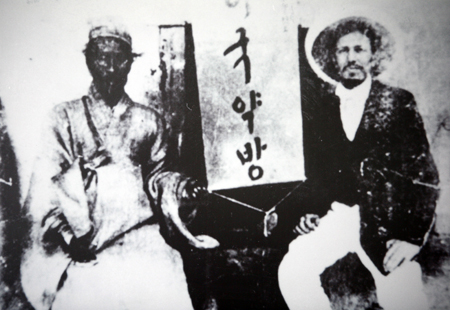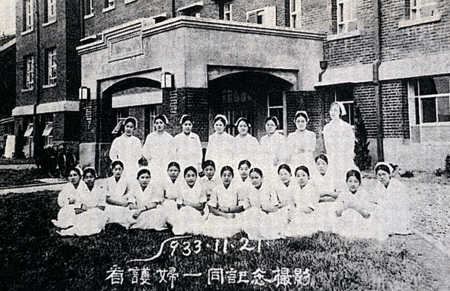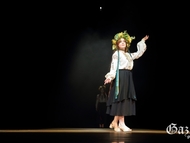
Keimyung University Dongsan Medical Center started from Jejungwon, an old hospital built by missionaries in 1899. A new Dongsan Medical Center will open in 2016. In this edition, the Gazette will introduce the 115 year history of Dongsan Medical Center and the new Dongsan Medical Center.
History
Jejungwon was built by a missionary, Woodbridge Odlin Johnson, in 1899. He started in a small thatched house located in Daegu Yangnyeongsi. In the beginning, his work was just prescribing drugs to people because the medical equipment that he brought from the United States to Busan had not arrived in Daegu. In this period, “American Pharmacy”' was engraved on Jejungwon’s signboard. However, the medical equipment that Johnson brought into Busan was transported to Daegu by a ship sailing on the Nakdong River and he started to treat patients in 1899. He carried out the first caesarean operation in Daegu in 1909. He also helped patients who suffered from leprosy and smallpox.
Jejungwon collapsed because of a typhoon in 1905 and was rebuilt in 1906. After rebuilding Jejungwon, Johnson recruited seven young people and taught them Western medicine. The young people studied anatomy, physiology, pharmacology, internal medicine, and English. Then, in 1910, Archibald Gray Fletcher became the new director and the name of the hospital was changed to Dongsan Christian Hospital. The hospital developed steadily. Fletcher built more buildings for the hospital thanks to the aid of philanthropists and American churches.

In 1948, a nursing high school affiliated with Dongsan Christian Hospital opened.
Then, in 1953, Dongsan Christian Hospital constructed a children’s hospital thanks to the aid of the United Nations Korean Reconstruction Agency (UNKRA) and Armed Forces Assistance to Korea (AFAK). The children’s hospital was for taking care of war orphans after the Korean War. In 1974, the nursing high school changed to a nursing vocational school. The nursing vocational school changed to Dongsan Nursing Junior College in 1979, the Department of Nursing Science in the Medical College of Keimyung University in 1990, and the College of Nursing in Keimyung University in 1993.
Dongsan Christian Hospital merged with Keimyung University in May 1982. The two organizations had operated independently before the merger. However, both organizations were established based on the Christian spirit and had the same purpose, the development of the region, community service, and increasing human resources. After the merger, the hospital’s name was officially changed from Dongsan Christian Hospital to Dongsan Medical Center. Dr. Jeon Do-gi was inaugurated as the first director of Dongsan Medical Center in September 1982.
Since 1982, Dongsan Medical Center has worked actively to publicize Daegu as a medical city. For example, Keimyung Foundation constructed Almaty Dongsan Hospital in Kazakhstan in 1996 and opened a promotional hall for medical tourism in Daegu in the hospital in 2012. Dongsan Medical Center has publicized Daegu by providing medical facilities in central Asian countries and giving medical care to poor countries in Asia and Africa. Furthermore, Dongsan Medical Center was appointed a neonatal intensive care center in Daegu by the Ministry of Health and Welfare in 2012. It has a budget of around 1.5 billion won and takes care of high risk infants.

New Dongsan Medical Center
A new Dongsan Medical Center will be built in 2016 and the construction is going on now. The new Dongsan Medical Center will be built on the Sungseo campus of Keimyung University. It will contain five underground levels and 20 stories above ground, and consist of 1033 rooms.
Dongsan Medical Center’s purpose is to be a hospital which has advanced facilities to take care of patients and a good environment to help patients feel comfortable during their treatment. Therefore, it will try to get certification from Joint Commission International. Certification from JCI is only given to a hospital which passes strict medical service standards such as Quality Improvement and Patient Safety (QPS), and it confirms the quality of medical care. Furthermore, Dongsan Medical Center will try to get a high level on Leadership in Energy and Environmental Design. LEED certifies a building is an energy-saving and eco-friendly building. LEED will confirm that the new Dongsan Medical Center has a good environment for patients.
Furthermore, special clinics such as a cardiovascular center, a cerebrovascular center, and a woman’s tumor clinic will be the major medical centers of the new Dongsan Medical Center. In the case of the cardiovascular center, it already carries out a ubiquitous medical service system. A ubiquitous medical service system means that patients who can’t come to a hospital easily can have treatment from the hospital thanks to equipment such as a web camera. The cardiovascular center installed imaging cameras in Dokdo and Ulleungdo, and diagnoses cardiac disorders through telemedicine. Furthermore, a ubiquitous medical service system operates all day long, so a doctor can treat patients even in emergency situations. Around 500 residents in Ulleungdo have used Dongsan Medical Center’s ubiquitous medical service system since 2008. In an interview, Lee Se-yeop, who is the director of Dongsan Medical Center, said that the new Dongsan Medical Center will attract not only local residents but also patients nationwide thanks to its advanced medical care.
Keimyung University Dongsan Medical Center started in a small thatched house in Yangnyeongsi and has developed into a big hospital which has diverse clinics and advanced medical facilities. Furthermore, it has contributed to the development of the local community through trying to make Daegu a medical city. The Gazette thinks that Dongsan Medical Center will be the hub of the medical industry in Daegu.









